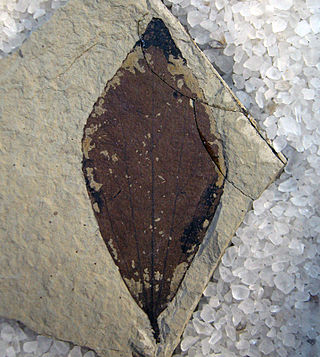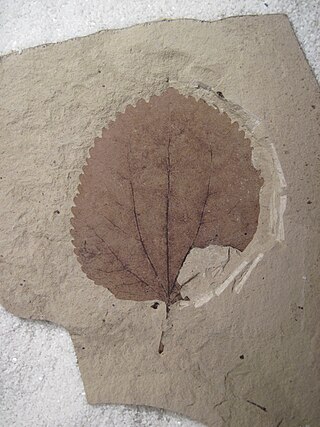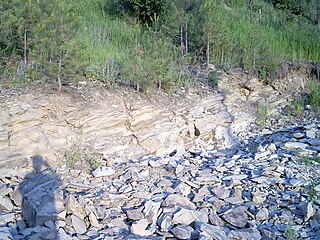
Neviusia, the snow-wreaths, is a genus of ornamental plants, which are native to the United States, containing two extant species and one extinct species known from fossil leaves. This genus is a rare example of a disjunct range occurring in North America. The type species, Neviusia alabamensis, occurs in several southeastern states, while second extant species, Neviusia cliftonii, is endemic to the Mt Shasta region of California, and the extinct species Neviusia dunthornei is found in shale deposits in the Okanagan Highlands of Washington and British Columbia. It is named for Episcopal priest and botanist Reuben Nevius.

Trochodendron nastae is an extinct species of flowering plant in the family Trochodendraceae known from fossil leaves found in the early Eocene Ypresian stage Klondike Mountain Formation deposits of northern Washington state. T. nastae is one of the oldest members of the genus Trochodendron, which includes the living species T. aralioides, native to Japan, southern Korea and Taiwan and the coeval extinct species T. drachukii from the McAbee Fossil Beds near Cache Creek, British Columbia.
Trochodendron drachukii is an extinct species of flowering plants in the family Trochodendraceae known from a fossil fruiting structure found in the early Ypresian age Eocene fossils found in British Columbia, Canada. T. drachukii is one of the oldest members of the genus Trochodendron, which includes the living species T. aralioides, native to Japan, southern Korea and Taiwan and the coeval extinct species T. nastae from Washington state, United States.
Neviusia dunthornei is an extinct species of flowering plants in the family Rosaceae. The species is solely known from the early Eocene, Ypresian stage, Allenby Formation Lacustrine deposits near the town of Princeton, British Columbia.
Neoephemera antiqua is an extinct species of square-gill mayfly in the family Neoephemeridae that is known from early Eocene, Ypresian stage, lake deposits near the small community of Republic in Ferry County, Washington, USA.

Fothergilla malloryi is an extinct species of flowering plant in the family Hamamelidaceae known from fossil leaves found in the early Eocene Klondike Mountain Formation deposits of northern Washington state. The F. malloryi leaves are the earliest appearance in the fossil record of a member of the witchalder genus Fothergilla, which includes the living species F. gardenii, and F. major, both of which are native to the southeastern United States. The genus also includes three or four other fossil species with two Asian Miocene species, F. viburnifolia from China, F. ryozenensis from Japan along with one Miocene North American species, F. praeolata of Oregon. Fothergilla durhamensis described from Eocene sediments in King County, Washington is considered dubious in placement, and it was transferred to the genus Platimeliphyllum by Huegele et al. (2021).

Corylopsis reedae is an extinct species of flowering plant in the family Hamamelidaceae known from fossil leaves found in the early Eocene Klondike Mountain Formation deposits of northern Washington state. C. readae is one of the oldest occurrences of the winter-hazel genus Corylopsis, which includes between seven and thirty species, all found in Asia. Fossils from two other occurrences are of similar age to C. readae, with Paleocene specimens from Greenland being placed in the form taxon Corylopsiphyllum and an Eocene Alaskan fossil being included in Corylopsis without species placement.

The Princeton Chert is a fossil locality in British Columbia, Canada, which comprises an anatomically preserved flora of Eocene Epoch age, with rich species abundance and diversity. It is located in exposures of the Allenby Formation on the east bank of the Similkameen River, 8.5 km (5.3 mi) south of the town of Princeton, British Columbia.

The Allenby formation is a sedimentary rock formation in British Columbia which was deposited during the Ypresian stage of the Early Eocene. It consists of conglomerates, sandstones with interbedded shales and coal. The shales contain an abundance of insect, fish and plant fossils known from 1877 and onward, while the Princeton Chert was first indented in the 1950's and is known from anatomically preserved plants.

Tsukada is an extinct genus of flowering plant in the family Nyssaceae related to the modern "dove-tree", Davidia involucrata, containing the single species Tsukada davidiifolia. The genus is known from fossil leaves found in the early Eocene deposits of northern Washington state, United States and a similar aged formation in British Columbia, Canada.

Charlotte Georgia Nast (1905-1991) was an American botanist and mycologist noted for her work as Curator of the Wood Anatomy Laboratory at Harvard University. Nast received her PhD in botany from the University of California, Berkeley in 1938. The fossil Trochodendron species T. nastae was named in honor of Nast. The standard author abbreviation Nast is used to indicate this person as the author when citing a botanical name.

Rhus boothillensis is an extinct species of flowering plant in the sumac family Anacardiaceae. The species is known from fossil leaves found in the early Eocene deposits of northern Washington State, United States. The species was first described from fossil leaves found in the Klondike Mountain Formation. Rhus boothillensis likely hybridized with the other Klondike Mountain formation sumac species Rhus garwellii, Rhus malloryi, and Rhus republicensis.
Rhus republicensis is an extinct species of flowering plant in the sumac family, Anacardiaceae. The species is known from fossil leaves found in the early Eocene deposits of northern Washington state in the United States. The species was first described from fossil leaves found in the Klondike Mountain Formation. R. republicensis likely hybridized with the other Klondike Mountain formation sumac species Rhus boothillensis, Rhus garwellii, and Rhus malloryi.

Tetracentron hopkinsii is an extinct species of flowering plant in the family Trochodendraceae. The species is known from fossil leaves found in the early Eocene deposits of northern Washington state, United States and south Central British Columbia. The species was first described from fossil leaves found in the Allenby Formation. T. hopkinsii are possibly the leaves belonging to the extinct trochodendraceous fruits Pentacentron sternhartae.
The paleoflora of the Eocene Okanagan Highlands includes all plant and fungi fossils preserved in the Eocene Okanagan Highlands Lagerstätten. The highlands are a series of Early Eocene geological formations which span an 1,000 km (620 mi) transect of British Columbia, Canada and Washington state, United States and are known for the diverse and detailed plant fossils which represent an upland temperate ecosystem immediately after the Paleocene-Eocene thermal maximum, and before the increased cooling of the middle and late Eocene to Oligocene. The fossiliferous deposits of the region were noted as early as 1873, with small amounts of systematic work happening in the 1880-90s on British Columbian sites, and 1920-30s for Washington sites. A returned focus and more detailed descriptive work on the Okanagan Highlands sites revived in the 1970's. The noted richness of agricultural plant families in Republic and Princeton floras resulted in the term "Eocene orchards" being used for the paleofloras.

The Eocene Okanagan Highlands or Eocene Okanogan Highlands are a series of Early Eocene geological formations which span a 1,000 km (620 mi) transect of British Columbia, Canada, and Washington state, United States. Known for a highly diverse and detailed plant and animal paleobiota the paleolake beds as a whole are considered one of the great Canadian Lagerstätten. The paleobiota represented are of an upland subtropical to temperate ecosystem series immediately after the Paleocene–Eocene thermal maximum, and before the increased cooling of the middle and late Eocene to Oligocene. The fossiliferous deposits of the region were noted as early as 1873, with small amounts of systematic work happening in the 1870–1920s on British Columbian sites, and 1920–1930s for Washington sites. Focus and more detailed descriptive work on the Okanagan Highland sites started in the late 1960s.

Ulmus chuchuanus is an extinct species of flowering plant in the family Ulmaceae related to the modern elms. The species is known from fossil leaves and fruits found in early Eocene sites of northern Washington state, United States and central British Columbia, Canada.
The Paleobiota of the Klondike Mountain Formation comprises a diverse suite of Early Eocene plants and animals recovered from North Central Washington State. The formation outcrops in locations across the north western area of Ferry County, with major sites in Republic, north west of Curlew Lake, and on the Toroda Creek area. The formation is the southern most of the Eocene Okanagan Highlands, sharing much of the paleoflora and paleofauna with site across Central and southern British Columbia.












